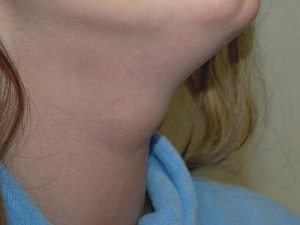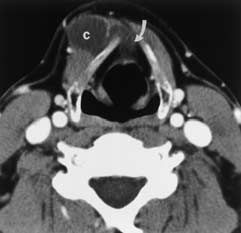A thyroglossal duct cyst often presents as a lump in the neck which may be painful. The thyroglossal duct is a structure which is important in the development of the thyroid gland in the embryo, and generally regresses in the majority of people. Thyroglossal duct cysts are most commonly diagnosed in patients before the age of 20; however, they can occur at any age.
Thyroid gland embryonic development
The thyroid gland starts to develop in the embryo very early in development; when the embryo is approximately 24 days old. The thyroid is found in the neck in the adult, but actually forms in the mouth initially. The thyroid starts off as a group of cells, forming near the base of the tongue. In order to reach its position in the adult, the cells of the primitive thyroid travel into the neck via a duct, known as the thyroglossal duct.
The thyroglossal duct connects the original position of the thyroid to its final position in the neck. In order for the thyroid to reach its adult position, it needs to travel through and near structures, such as the tongue, neck muscles and the hyoid bone. After the thyroid gland cells have descended, the cells of the thyroglossal duct divide and act to fill the previously hollow tube. Eventually, the thyroglossal duct regresses.
Thyroglossal duct cysts
In some people, the thyroglossal duct does not completely close and remains in the child, a condition known as a patent thyroglossal duct. The tube is open and forms a connection between the thyroid and the tongue. People with patent thyroglossal ducts are vulnerable to infections, and may develop thyroglossal duct cysts.
Thyroglossal duct cysts are closed sacs which form from patent thyroglossal ducts. They may be found at any point along the thyroglossal duct, but are most commonly found in the midline of the neck, just under a bone called the hyoid. Thyroglossal duct cysts often move when the patient is swallowing. It is possible for a thyroglossal duct cyst to be present and not cause problems, until the patient suffers from a cold or other kind of infection.
Treatment
Thyroglossal duct cysts are generally removed surgically. This is due to a number of complications that can arise from an infected cyst, as well as for cosmetic reasons for the patient. The preferred method of excision is known as the Sistrunk procedure, which involves removal of the thyroglossal duct cyst, along with the surrounding tissue and part of the surrounding hyoid bone. Part of the tongue may also be removed during the operation.
All excised thyroglossal duct cysts are sent to a pathology laboratory for examination. This is because around 1% of all thyroglossal duct cysts contain thyroid cancer cells; another important reason why most cysts undergo surgical removal.
Complications
Untreated thyroglossal duct cysts have a number of complications, especially if infected. Untreated cysts may also rupture, which leads to poorer outcomes. Recurrent and chronic infections are painful and can affect the patient’s ability to breathe and swallow normally. As with all operations, there are a few complications which may arise following surgical excision of a thyroglossal duct cyst. Infections are a common post-operative problem, and are more likely if the cyst has ruptured. There is a possibility that the thyroglossal duct cyst may come back after surgery; however, cysts that are excised using the Sistrunk procedure have a much lower rate of recurrence compared to simple excision of the cyst only.
The rate of recurrence following excision using the Sistrunk procedure is even lower when good surgical technique is employed. It is also more likely for a thyroglossal duct cyst to recur if the cyst has ruptured at some point. Patients with thyroglossal duct cysts are also more likely to have thyroid tissue located outside of its normal anatomical location; known as ectopic thyroid tissue. Imaging is usually performed prior to surgery to determine whether or not ectopic thyroid tissue is present and thyroid function tests are also performed.
Find out more
For more information about thyroglossal duct cysts click here.
